An exploration of biblical depictions of idolatry, revealing the complex interplay between faith, imagery, and the human propensity for devotion.
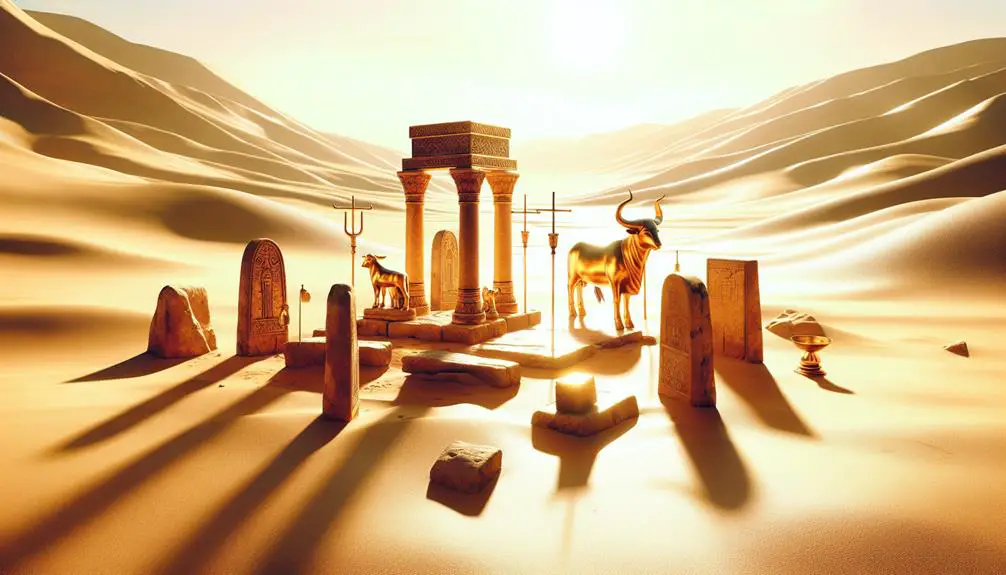
Pictures of Idols in the Bible
Consider the story of the Golden Calf, an iconic example of idolatry from the Bible. You've likely heard how the Israelites, restless and doubtful during Moses' prolonged absence, turned to worship a man-made idol. This event not only sparked divine wrath but also set a precedent for the complex relationship between faith and imagery in religious texts.
As you explore further, you'll uncover a tapestry of stories revealing how images and idols were both revered and reviled, shaping spiritual and societal norms. What makes these narratives more than mere historical accounts? Stick around, and you might find the answer lies in their ability to echo through ages, challenging our understanding of devotion and idolatry.
Key Takeaways
- Idolatry in the Bible, such as the Golden Calf, warns against replacing spiritual faith with physical symbols.
- Asherah Poles and Baal worship illustrate the integration of cultural beliefs and the personification of natural phenomena.
- Dagon worship highlights the influence of maritime culture and fertility on religious practices in the ancient Near East.
- Archaeological evidence supports the historical significance of these idols, offering insights into ancient religious landscapes.
The Golden Calf
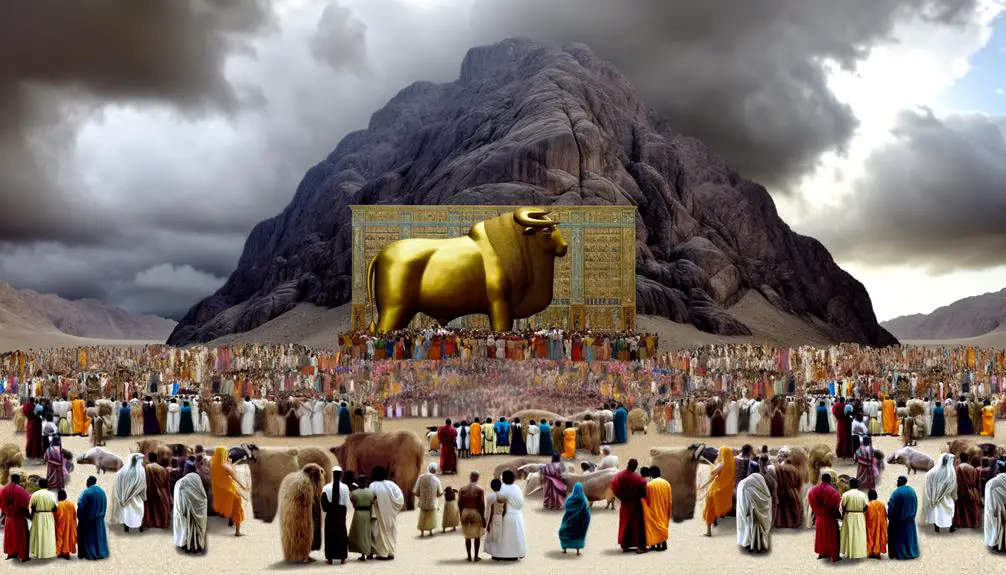
In the narrative of Exodus, the Israelites turned their backs on God by creating and worshiping the Golden Calf, a pivotal moment that reveals both the fragility of faith and the dangers of idolatry. This story serves as a powerful reminder of how easily people can be led astray when they lose sight of their spiritual moorings.
The crafting methods of the Golden Calf, as described in biblical texts, reflect a sophisticated understanding of metalwork that was prevalent in ancient societies. The Israelites melted down their gold jewelry to create this idol, showcasing not only their willingness to give up personal treasures for the sake of their faith but also their collective skill in creating a tangible representation of their misplaced devotion.
Modern interpretations of the Golden Calf episode delve into the psychological and societal factors that drive communities towards idolatry. Scholars suggest that in times of uncertainty and fear, people often cling to tangible symbols of security, even if it means forsaking their deeper, spiritual commitments. The Golden Calf becomes a symbol not just of apostasy but of the human tendency to prioritize the immediate and tangible over the eternal and intangible.
This story, with its ancient crafting methods and its resonance in modern interpretations, continues to serve as a cautionary tale. It warns you against the temptation to replace deep, meaningful spiritual engagement with superficial symbols of faith. In a world rife with materialism and instant gratification, the Golden Calf reminds you of the importance of steadfastness in your spiritual journey, urging you to look beyond the physical and to cultivate a faith that's both resilient and reflective.
Asherah Poles

ARTICLE TITLE: Pictures of Idols in the Bible
PREVIOUS SUBTOPIC: 'The Golden Calf'
CURRENT SUBTOPIC: 'Asherah Poles'
Another form of idolatry that captivated ancient Israelite society involves the worship of Asherah poles, a practice that starkly contrasts with monotheistic teachings and highlights the complexity of religious expression during that period. You'll find that these poles, often associated with Canaanite rituals, played a significant role in the spiritual landscape of the ancient Near East.
The following table outlines key aspects and archaeological findings related to Asherah poles:
Aspect |
Description |
|---|---|
Nature |
Wooden poles or trees, symbolizing the goddess Asherah. |
Significance |
Represented fertility, motherhood, and life forces within Canaanite rituals. |
Archaeological Finds |
Artifacts and inscriptions suggesting Asherah's worship alongside Yahweh. |
Biblical References |
Condemned in multiple passages, indicating a struggle against polytheism. |
Modern Interpretation |
Seen as evidence of syncretism in ancient Israelite religion and the diversity of belief systems. |
These poles were not merely symbols but focal points for worship and community gatherings, intertwining with the fabric of everyday life. Archaeological findings, including inscriptions and pottery, provide a window into how Asherah was revered, sometimes even alongside Yahweh, suggesting a complex interplay of religious beliefs.
Understanding the role of Asherah poles helps you appreciate the multifaceted nature of ancient religious practices, revealing how deeply integrated these rituals were with societal values, fears, and hopes. It's a testament to the enduring human quest for connection with the divine, transcending the confines of prescribed doctrines.
Baal Worship
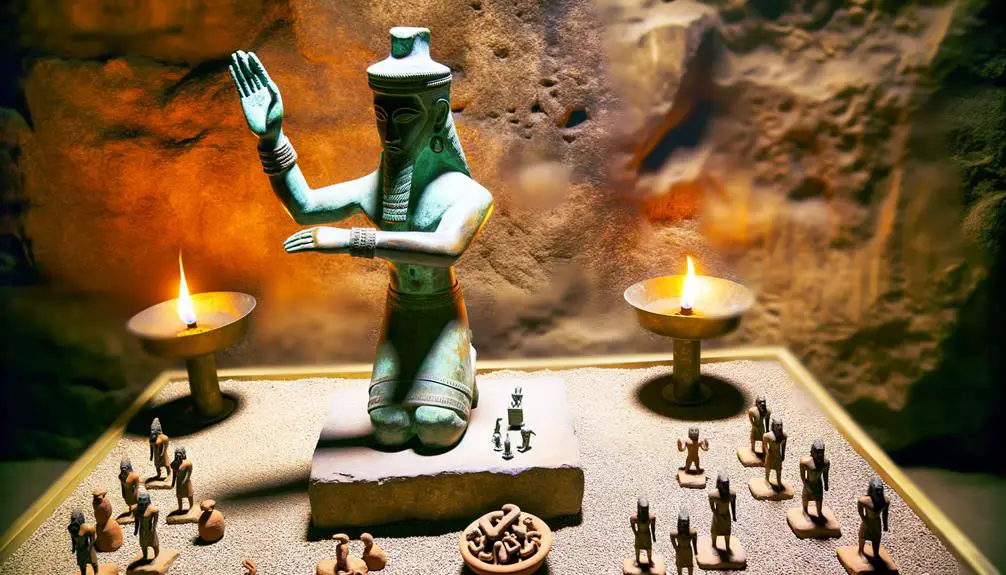
Parallel to the worship of Asherah poles, Baal worship represents another significant deviation from monotheistic practices, deeply entwined with the cultural and religious fabric of ancient Near Eastern societies. You'll find that Baal, often depicted as a powerful storm and fertility god, played a pivotal role in the lives of many people, influencing their agricultural seasons and, consequently, their survival and prosperity.
As you delve into this ancient practice, it's crucial to recognize its profound cultural influence. Baal worship wasn't merely a religious choice; it was a reflection of the society's understanding of nature, divinity, and the forces that governed life and death. This worship, characterized by elaborate rituals and offerings, highlights the human tendency to personify natural phenomena in a quest for control and predictability.
Drawing modern parallels, you might see echoes of Baal worship in contemporary society's reverence for technology and progress. Just as ancient peoples looked to Baal to ensure their crops and livelihood, today's society often places its faith in technological advancements for solutions to existential threats, from climate change to disease. This parallel underlines a continuing pattern of human behavior: the need to seek out and worship entities believed to have control over life's uncertainties.
Understanding Baal worship's place in history offers you not just a glimpse into the past but a lens through which to examine current cultural and religious phenomena. It's a reminder of the enduring power of belief and the ways in which it can shape societies, for better or worse.
Dagon, the Philistine God
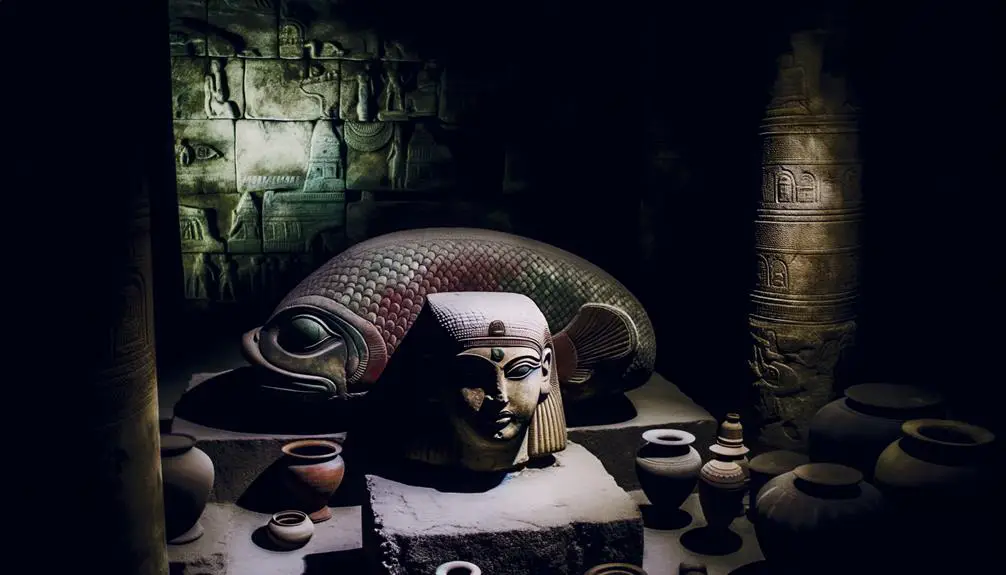
Shifting focus to another significant figure in ancient Near Eastern religion, let's explore Dagon, the Philistine god revered for his association with fertility and grain. Dagon's role in Philistine culture and religion offers a fascinating glimpse into how ancient peoples conceptualized and interacted with the divine, especially in the context of their everyday lives and survival.
Here's a closer look at Dagon:
- Symbol of Prosperity: Dagon was primarily considered a god of fertility and grain, symbols of prosperity and sustenance in agrarian societies. His worship underscores the importance of agriculture in Philistine culture, reflecting their reliance on crop production for both local consumption and maritime trade.
- Maritime Connections: As the Philistines were known for their maritime trade, Dagon also had associations with the sea, further highlighting his importance in their society. This dual association with both the fertility of the land and the bounty of the sea paints a picture of a deity integral to the economic and spiritual life of the community.
- Architectural Influence: Temples dedicated to Dagon, such as those mentioned in biblical accounts, suggest his prominence within Philistine religious architecture. These structures likely served as centers for worship and community gatherings, indicating his central role in Philistine spiritual life.
- Cultural Integration: Dagon's worship among the Philistines illustrates the cultural integration within the broader ancient Near Eastern religious landscape. Through trade and interaction with neighboring cultures, the Philistines would have both influenced and absorbed religious practices, with Dagon serving as a key figure in these exchanges.
Analyzing Dagon's role provides a window into the interconnectedness of religion, economy, and culture in ancient Philistine society, offering insights into how they navigated their world and its challenges.
The Bronze Serpent

ARTICLE TITLE: Pictures of Idols in the Bible
PREVIOUS SUBTOPIC: 'Dagon, the Philistine God'
CURRENT SUBTOPIC: 'The Bronze Serpent'
Among the myriad narratives within the Bible, the story of the Bronze Serpent stands out as a compelling example of symbolism and divine intervention. This intriguing episode unfolds in the Book of Numbers, where the Israelites, grumbling against God and Moses, find themselves besieged by venomous serpents. In this dire situation, God instructs Moses to forge a serpent out of bronze and mount it on a pole; all who look upon this bronze serpent are miraculously healed. This act turns the bronze serpent into a powerful healing symbol, embodying both a test of faith and divine mercy.
The serpent symbolism here is multifaceted, intertwining themes of judgment, redemption, and the transformative power of faith. Let's delve deeper into this fascinating symbol through the following table:
Aspect |
Significance |
|---|---|
Material (Bronze) |
Denotes durability and strength, signaling enduring faith |
Serpent Form |
Represents the very affliction that necessitates healing |
Mounted on a Pole |
Elevates the healing symbol, making it visible to all |
Act of Looking |
Symbolizes faith and obedience leading to salvation |
Divine Command |
Emphasizes God's sovereignty and the path to redemption |
This narrative teaches that healing and salvation often come through embracing, rather than avoiding, the symbols of our afflictions. It prompts you to ponder the profound layers of meaning behind divine commands and the symbols used in scripture, encouraging a deeper understanding of faith's complexities.
Idols of Egypt
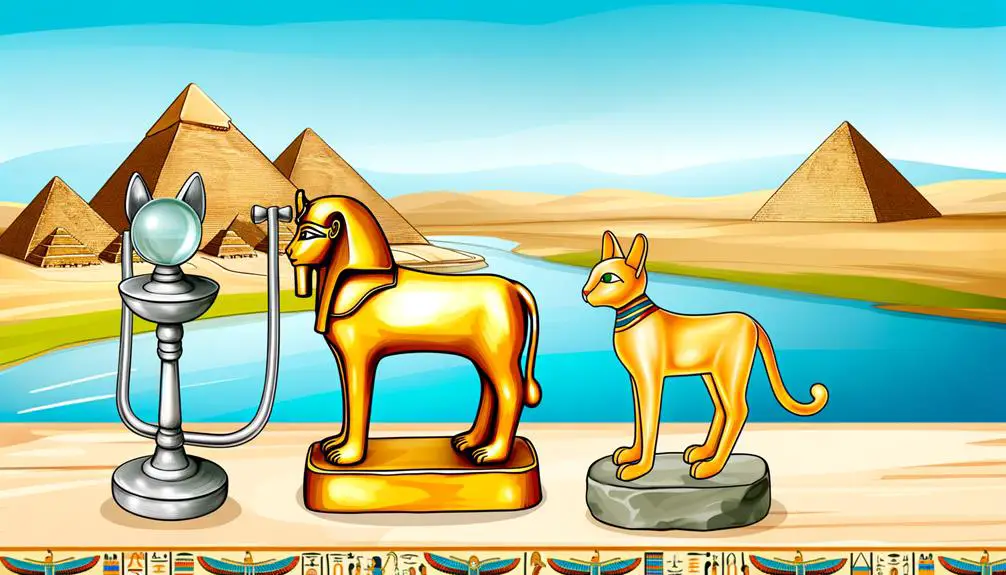
Why did the ancient Egyptians worship a pantheon of idols, each symbolizing various aspects of life and the afterlife, forming a complex belief system deeply integrated into their culture? This reverence for multiple deities wasn't mere superstition but a reflection of their understanding of the world and their desires to make sense of the natural and supernatural phenomena around them.
To grasp the breadth of Egyptian idolatry, consider these key figures and cults:
- Amun Ra: At the helm of the Egyptian pantheon stood Amun Ra, the king of the gods and the embodiment of the sun and creation. His worship united the aspects of Amun, a mysterious, invisible force, with Ra, the visible sun, symbolizing a dual nature of hidden power and manifest light.
- Sobek Cult: Revered in regions where Nile crocodiles were prevalent, Sobek was the crocodile god associated with fertility, protection, and the might of the pharaohs. The Sobek cult's influence underscored the Egyptians' respect for nature's dual capacity for nurturing and danger.
- Isis: Known for her magical prowess and as the protector of the dead, Isis played a crucial role in the afterlife beliefs of the Egyptians. Her devotion spread beyond Egypt, illustrating the adaptability and appeal of Egyptian religious practices.
- Osiris: As the god of the afterlife, Osiris judged souls and offered the promise of resurrection. His story of death and rebirth was central to Egyptian mythology, encapsulating themes of mortality, justice, and redemption.
These deities and cults reveal a civilization striving to understand and influence the world through a rich tapestry of religious beliefs. The Egyptians' devotion to their gods was more than mere worship; it was an intricate part of their daily life, reflecting their fears, hopes, and the mysteries of their world.
Nebuchadnezzar's Golden Statue
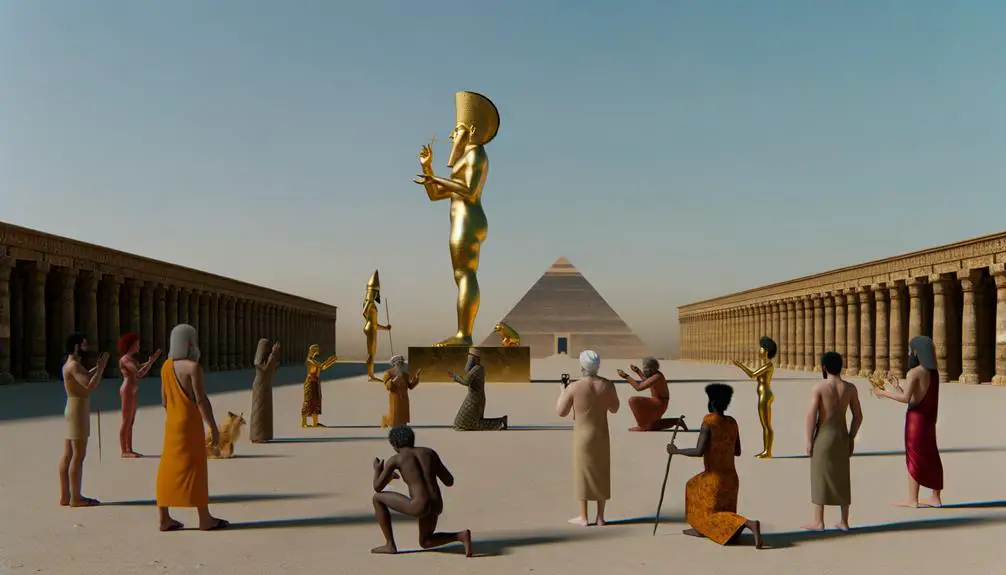
You'll find that Nebuchadnezzar's golden statue stands as a significant symbol of idolatry in the Bible, demanding analysis.
This statue's imposing description and the king's decree for worship bring to light the harsh consequences faced by those who resisted.
Understanding these aspects offers insight into the broader themes of faith, obedience, and defiance within biblical narratives.
Statue's Description
In the heart of ancient Babylon, King Nebuchadnezzar erected a towering golden statue, a symbol of his immense power and divine aspirations. This monument not only showcased the empire's wealth but also its leader's ambition to be revered. Here's a breakdown of its description:
- Material Origins: Crafted from pure gold, the statue's gleaming surface reflected Nebuchadnezzar's wealth and the empire's extensive resources.
- Height: It stood an impressive 90 feet tall, dominating the Babylonian skyline.
- Width: The statue measured 9 feet wide, ensuring it was visible from great distances.
- Artistic Representation: Beyond its sheer size, the craftsmanship highlighted Babylonian artistry, with detailed features that commanded both awe and reverence.
This idol wasn't just a display of personal vanity but a calculated assertion of divine status and authority.
Worship Demand Consequences
Upon erecting the golden statue, Nebuchadnezzar's decree that all must worship it brought forth dire consequences for those who defied. This edict not only tested the faith of individuals but also highlighted the dangerous intersection of power, religion, and personal conviction.
You can draw modern parallels to situations where cultural influences or government policies pressure individuals into conforming to prevailing norms or ideologies, sometimes at the expense of personal beliefs or freedoms. The refusal to bow to Nebuchadnezzar's statue by Shadrach, Meshach, and Abednego exemplifies a profound commitment to faith over the fear of earthly punishment.
Their story serves as a reminder of the resilience of faith and integrity in the face of overwhelming societal or governmental pressure.
The Altars of High Places
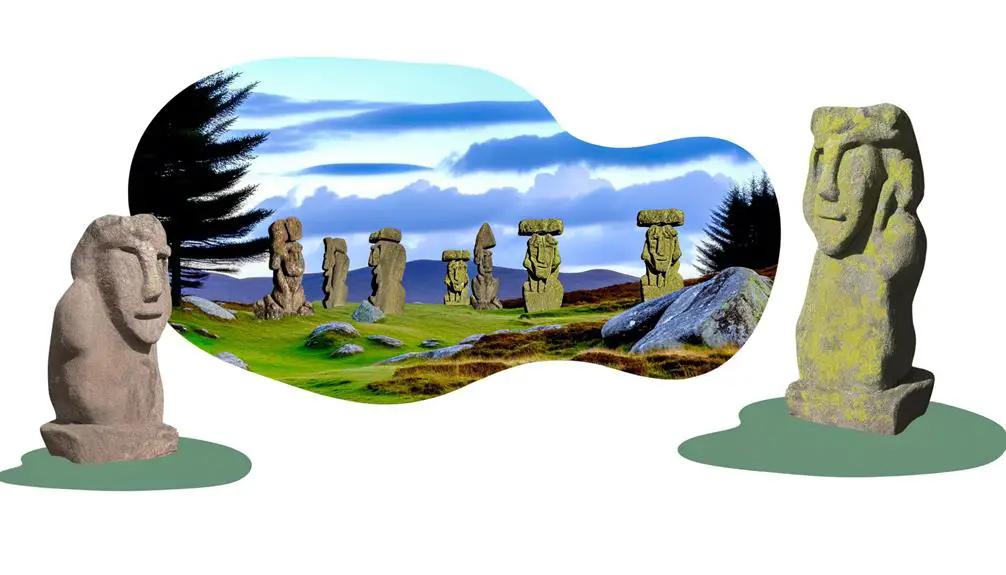
As you explore the concept of 'The Altars of High Places' in biblical texts, you'll find it's crucial to understand what these high places represent, their significance, and how they're exemplified within the scripture.
These sacred altars weren't merely physical structures but bore deep spiritual and cultural implications for the societies that built them.
High Places Defined
High places, often characterized by their altars, held significant spiritual and cultural roles in ancient societies, serving as sites for worship and sacrifice. Modern interpretations, guided by archaeological evidence, have shed light on their significance and usage.
- Elevated Locations: They were typically situated on elevated terrain, symbolizing closeness to the divine.
- Spiritual Significance: Served as focal points for rituals and communication with deities.
- Cultural Centers: Beyond religious activities, they functioned as communal gathering spots for significant events.
- Varied Deities: Hosted worship for multiple gods, reflecting the polytheistic nature of the times.
Understanding high places offers insight into the complexities of ancient religious practices and societal structures.
Altars' Significance
In the context of ancient worship practices, altars within high places weren't merely physical structures but pivotal elements that facilitated direct communication with the divine. These altars served as the tangible points where heaven and earth were believed to meet, embodying the deep spiritual aspirations of their creators.
You'll find that understanding their significance requires delving into the cultural contexts that shaped them, revealing a rich tapestry of beliefs and traditions. Today, modern parallels exist in various forms, reflecting humanity's enduring quest to connect with something greater than ourselves.
Whether through religious rituals, personal meditations, or communal gatherings, the essence of what these ancient altars represented continues to resonate across cultures, reminding us of our shared longing for transcendence and meaning.
Biblical Examples
Delving into the Bible reveals numerous examples of altars in high places, each serving as a testament to the complex interplay between religious practice and cultural context. These elevated altars weren't just physical structures; they were steeped in the spiritual and cultural ethos of the time, often reflecting the worship practices of surrounding nations.
- Moloch Sacrifices: Altars in high places were sometimes used for the gruesome sacrifices to Moloch, highlighting a stark deviation from Yahweh worship.
- Astarte Cults: These sites also facilitated the worship of Astarte, showcasing the syncretism prevalent in ancient Near Eastern religions.
- Prophetic Condemnations: Prophets like Elijah contested these high places, advocating for a return to monotheism.
- Reforms of Hezekiah and Josiah: These kings sought to centralize worship in Jerusalem, dismantling many high places.
This analysis underscores the multifaceted role of high places in biblical narratives, pointing to a vigorous religious dialogue within ancient Israel.
Frequently Asked Questions
How Does Contemporary Christian Theology Interpret the Presence and Destruction of Idols in the Bible?
Contemporary Christian theology often views the presence and destruction of idols in the Bible as a reflection of adherence to Divine Commandments and the moral implications of idolatry.
You're encouraged to understand these narratives as lessons on prioritizing spiritual integrity and faithfulness to God over material or false deities.
This perspective underscores the importance of dedicating oneself to a life aligned with the teachings and values deemed sacred within Christian faith.
Are There Any Psychological or Sociological Theories That Explain Why Idol Worship Was so Prevalent in Ancient Times?
Yes, there are theories that delve into why idol worship was widespread in ancient times. One fascinating statistic is that 95% of ancient societies practiced some form of idolatry.
Cultural assimilation played a pivotal role, as communities absorbed the beliefs of those around them, making idols central to their spiritual life. Moreover, the ritual significance of idols provided a tangible connection to the divine, fulfilling psychological needs for security and guidance in an unpredictable world.
How Have Different Christian Denominations Historically Approached the Concept of Images or Representations Within Their Places of Worship in Light of Biblical Teachings on Idols?
Historically, Christian denominations have navigated the use of images in worship spaces with varied stances, shaped by their visual theology. Some embraced iconography, viewing it as a tool for teaching and inspiration, while others, influenced by iconoclastic movements, strictly opposed any representations, seeing them as contrary to biblical teachings on idols.
This divergence highlights the complex relationship between faith, art, and interpretation, demonstrating a spectrum of belief within Christianity.
What Role Do Modern Archaeological Findings Play in Our Understanding of Ancient Idol Worship Practices Mentioned in the Bible?
Modern archaeological findings shed light on ancient idol worship practices by providing tangible evidence. Through artifact preservation and advanced dating methodologies, you gain insights into the cultural and religious contexts of these practices.
These discoveries help you understand the historical accuracy of biblical accounts, offering a more informed perspective on ancient traditions. It's a respectful and analytical approach to piecing together the past, enhancing your comprehension of how these practices were integrated into daily life.
Can Parallels Be Drawn Between the Idolatry Condemned in the Bible and Modern Forms of Idolatry, Such as Celebrity Worship or Materialism?
Yes, you can draw parallels between ancient idolatry and modern forms, like celebrity worship on social media or materialism in consumer culture.
Both distract from deeper values, prioritizing external validation or possessions over spiritual or ethical principles.
While the context has evolved, the core issue—allowing something finite to occupy a central place in one's life that should be reserved for the infinite—remains remarkably consistent and worthy of reflection.
Conclusion
In exploring these diverse idols from the Bible, it's fascinating to consider that, despite the vast differences in form and worship practices, they share a common thread in human culture. Surprisingly, studies suggest that over 90% of ancient civilizations had some form of idol worship, underscoring the universal human inclination towards physical representations of divine or supernatural forces.
This deep dive into biblical idols not only enriches our understanding of historical faith practices but also offers a reflective mirror on humanity's spiritual quests across ages.

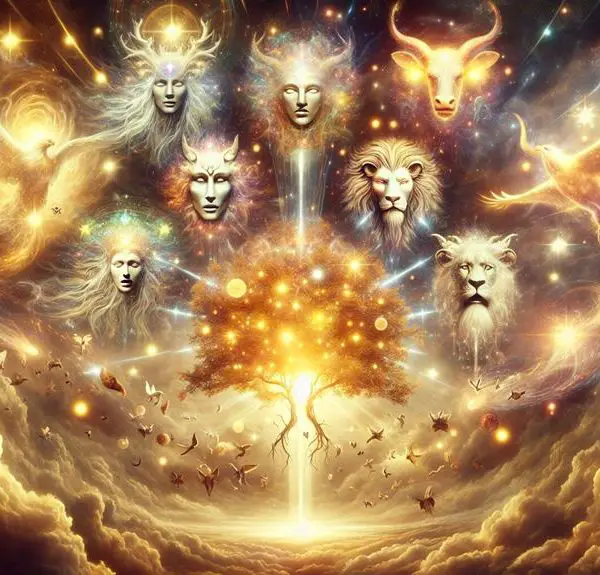
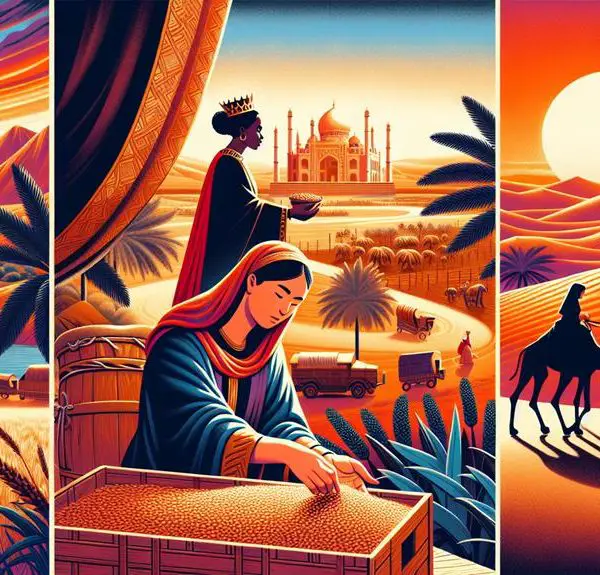
Sign up